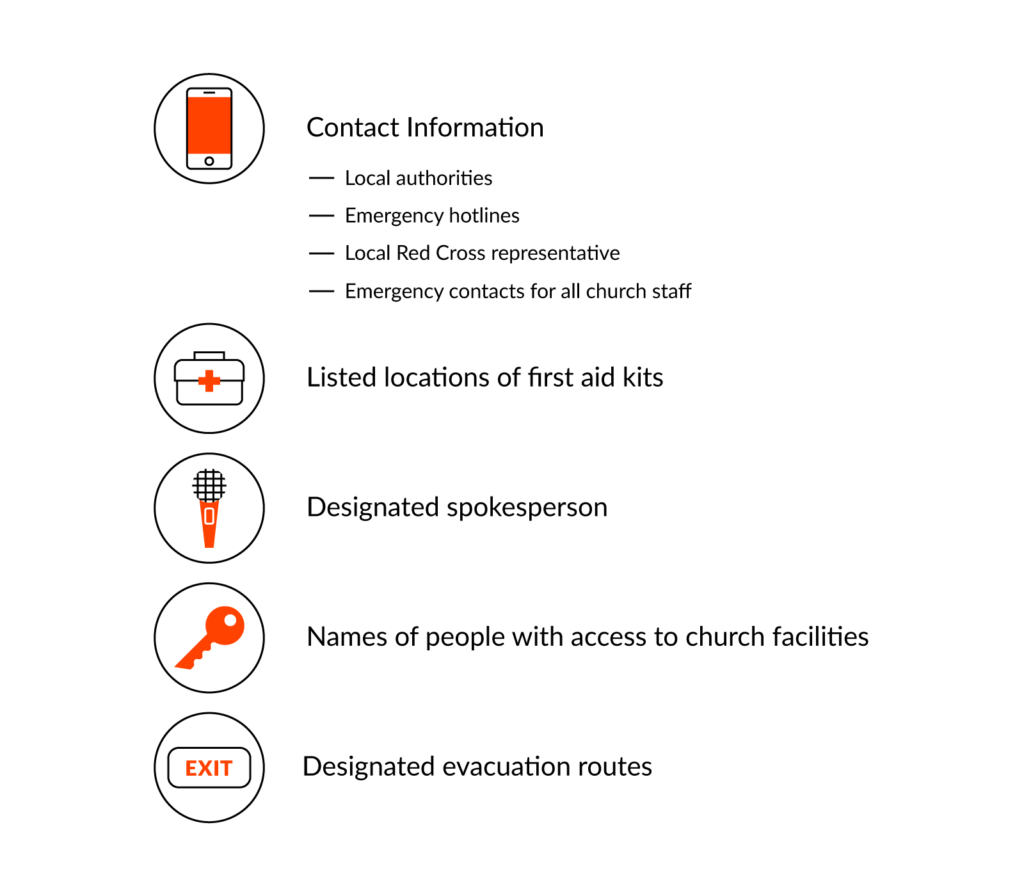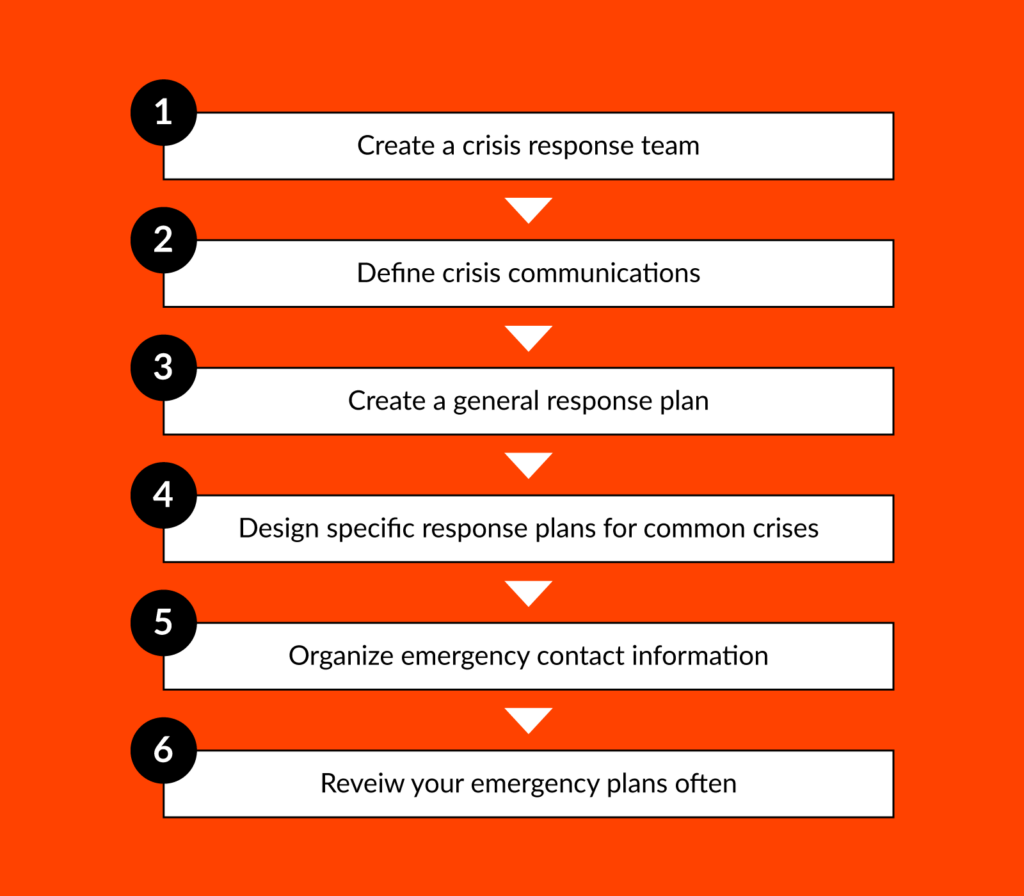From church leaders stepping down unexpectedly to disaster response, you need a church crisis management plan for when situations arise and begin to deteriorate quickly. According to Barna, only 15% of pastors feel completely prepared to lead a congregant through a significant trauma. That number is far too low for the person and community people rely on in those times.
It may seem extreme to consider having a response plan in place for a variety of crises, but it is actually an integral part of pastoring a local church.
When disaster strikes in your congregation, your phone will likely be one of the first ones to ring. So you and your staff members need to be prepared. I am going to walk you through defining church crisis management, why you need a church crisis management plan, what needs to be included in it, and how to start setting one up right away.
I’ll cover:
- What Is A Church Crisis Management Plan?
- What Is Church Crisis Management?
- Why Is A Church Crisis Management Plan Important?
- What To Include In A Crisis Management Plan
- How To Create A Crisis Management Plan
What Is A Church Crisis Management Plan?
A church crisis management plan is a document or standard operating procedure that can be applied anytime an emergency response is needed. It will include phone numbers for appropriate authorities, contact information for key church leaders and community leaders that may need to be communicated with, and an overall plan for emergency management.
Now, this might sound intimidating, but you likely already have the vast majority of this information at your fingertips. You know who to call, and you might even have some of the telephone numbers in your phone already. You just need to organize it into a standardized document that key church staff have easy access to, alongside an emergency plan and church security manual that is ready to implement.
Think of it like this: there is no way you can be prepared for every type of crisis, but you can prepare yourself and team members for the process of dealing with church crisis situations. Before we dig into the specifics, let’s assess what we mean when we talk about church crisis management.
What Is Church Crisis Management?

During my time in ministry, I helped manage crises such as teenagers being threatened with expulsion from school, neighborhood shootings, church leader scandals, and so much more. At the end of the day, the way you handle these are all far more similar than they are different.
Let’s loosely define church crisis management as any time in which the response plan involves an immediate physical or psychological threat to someone or something that necessitates the involvement of authorities outside the church offices.
As we have laid out in a further article on church crisis management, the process usually involves the following:
- Focus on mitigating the negative effects and attempt to stop further harm from occurring
- Prepare for future crises
- Respond using all the information and resources you have at hand
- Take time to recover afterward
It is a pretty straightforward process that involves taking everything one step at a time and remaining as prepared, calm, and understanding as possible. But what defines a crisis?
Well, crisis is defined as a time of intense difficulty, trouble, or danger. For most of us, that feels a bit like the daily work we do. The operative word here, though, is intense. When it feels like law enforcement has to be involved, the church building is in imminent danger, or even a shelter in place order has been called, that definitely constitutes a crisis.
Why Is A Church Crisis Management Plan Important?
As we have already discussed and outlined, a time of crisis is any time church staff feel they are out of their depth and outside authorities are required to become involved.
If you have gotten to the point that a response team that requires law enforcement, doctors, bomb threat squads, etc. to be called in, then you have moved fully into a time of crisis for your local church.
It’s important to note, though, that even the involvement of organizations like Child Protective Services, first responders, or even your insurance company can qualify as times of crisis. These may seem like much more mundane examples, but they meet all of our qualifications and deserve every ounce of our attention when it comes to disaster preparedness.
Having a church crisis management plan in place simply prepares your staff members to be prepared for things like natural disasters, severe weather, active shooter scenarios, medical incidents such as someone fainting, a child reporting being touched inappropriately, or fire extinguishers being used.
There is a famous saying that a failure to plan is a plan to fail. Our congregation deserves to see the church property and church staff as safe. One way you can show the love of Jesus in even the most regular and mundane ways is by helping others know there is a plan for when things go sideways.
What To Include In A Crisis Management Plan
The vast majority of the content going into your church crisis management plan is going to be centered around crisis communications. Time and time again communication will be the single-most deciding factor on how to handle any given crisis.
That being said, here are a few of the most common things to include in any crisis management plan:

- Contact information for local authorities
- Phone numbers for a variety of hotlines such as poison control and the suicide hotline
- Listed locations of all first aid kits, AED equipment, and a list of who is trained and certified to properly use this equipment
- The designated spokesperson for the church in any given situation (typically the Lead Pastor)
- Point of contact for a local American Red Cross representative, if possible
- Emergency contact information for all church staff
- Names of those with access and their means of access to the church facilities
- A general process of how crisis communications should flow to and from the designated spokesperson
- When or if a media contact should be a consideration
- Designated evacuation routes for both the building as well as the local area
The list could go on and on, but this is a great place to start for knowing what information to start gathering.
How To Create A Crisis Management Plan

When it comes to creating a church crisis management plan for your own congregation, there is no right or wrong way to do it. Typically, it is a good idea to have it easily accessible digitally for all of your church leaders and church staff, but keeping copies in designated areas on site is another great idea.
In general, though, you will want to organize the information as simply and clearly as possible. When disaster strikes people do not often think clearly, so clarity in a crisis management plan will be key.
With that in mind, here is how we suggest organizing your crisis management plan:
- Create a crisis response team
- Define crisis communications
- Create a general response plan
- Design specific response plans for the most common situations
- Organize emergency contact information
- Review your emergency plans often
1. Create a Crisis Response Team
The first step to create a church crisis management plan is to create a response team, or church security team.
This does not have to be a separate team from your elders, your church staff, or your volunteers. It can overlap with these already established teams or it can include a representative from each that will meet annually to review (more on that later).
Either way, before you begin you are going to need to have key people who are dedicated to preparing and reviewing this information who are all on the same page. More importantly, it shouldn’t rest entirely on the Lead Pastor’s shoulders either.
Your crisis response team will all be equally informed and prepared for times of crisis and should, therefore, all have a hand in its updating and creation.
An important note: even if the Lead Pastor is NOT directly involved in the response team, they will likely be required to be the designated spokesperson and will be intricately involved in the creation of the initial church crisis management plan.
2. Define Crisis Communications
This will be the beginning of the actual organizing of your church crisis management plan. Crisis communications are going to be the most gargantuan task any time disaster strikes. Having a clearly defined path and process will make these situations calmer, more relaxed, and more easily resolved.
Your crisis response team will need to determine things like:
- How soon does the spokesperson need to be looped in on any given situation?
- At what point do authorities need to be involved?
- Do we create a general rule for media contact in these heightened emotional state types of situations?
- When do others involved, directly or otherwise, become a part of the crisis response plan?
You will not be able to create a plan for every situation, but having a rule in place such as the following: “The spokesperson for the church facilities will be contacted as soon as a member of the crisis response team becomes aware of the current or future involvement of local authorities” Plans like this will go a long way to making everyone feel much more prepared for these tragic situations.
Do not simply list these questions and answers but form each answer as a “rule of crisis response” that can be applied to any given situation.
Keep these as short, sweet, and understandable as possible. These will likely exist on page one of your church crisis management plan, so try to condense everything down to that single page for the sake of simplicity.
3. Create a General Response Plan
Now that you have your crisis communications plan in place, all you need to do is create a “general response plan” that can apply to pretty much all situations in as plain of language as possible.
This general response plan will exist on page two of your document. Again, come up with a simple process that gives a general plan for how to respond to any given crisis without bogging down the details right away.
Think of this as the vision statements for your crisis response team. These are less standard operating procedures and more of codes of conduct. I suggest reviewing the process of: mitigate, prepare, respond, and recover mentioned earlier in this article.
4. Design Specific Response Plans for Common Crises
Your next few pages will likely depend on your congregation, culture, and local community. These are going to be response plans specific to some of the most common types of crises for your local church.
For example, if you live in Florida, then a hurricane response plan likely makes sense. It would not make sense to have the same plan in place in Ohio, for example. Likewise, having a flood response plan in the Nevada Desert doesn’t make sense but it does in Eastern Kentucky.
Here are some suggested response plans to put in place for most houses of worship:
- Child endangerment
- Active shooter
- Natural disaster (specific to your area)
- Medical emergency
5. Organize Emergency Contact Information
This one is pretty straightforward: you need a list of the relevant contact information that might be needed at a moment’s notice.
This would, of course, have the phone numbers for local law enforcement but might also include contact information for people and organizations such as:
- The nearest emergency room
- A local American Red Cross representative (if possible)
- Child Protective Services
6. Review Your Emergency Plans Often
The last step in how to create your church crisis management plan is to not think of it as a one-and-done project. Your crisis response team needs to be reviewing, tweaking, and adjusting your crisis management plan at least once a year.
Ideally, after every major crisis, a follow-up meeting should be considered to evaluate how things went and what can be improved for the next time.
Your church crisis management plan is never “complete” because there will always be a fresh, new crisis just around the corner. It is part of the human condition and nothing to be worried or ashamed of.
Your Church Crisis Management Plan Can Help Prevent Crisis
Want to know the best part of building out this amazing church crisis management plan? It can actually serve as a preventative measure!
When businesses and nonprofits have emergency plans in place, it often results in a reduction of crises all together! It is a concept known as risk mitigation and leads to people often acting and behaving differently when they feel safe, secure, and protected. Having a church security plan in place can also help prevent some types of incidents before they happen.
Read about creating a church security checklist here. This document complements your crisis management plan nicely.



